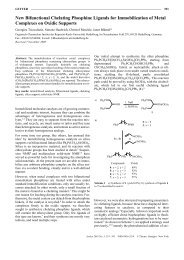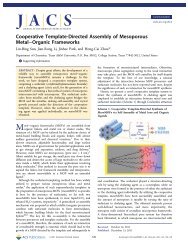X-ray powder diffraction characterization of the elusive ...
X-ray powder diffraction characterization of the elusive ...
X-ray powder diffraction characterization of the elusive ...
Create successful ePaper yourself
Turn your PDF publications into a flip-book with our unique Google optimized e-Paper software.
X-<strong>ray</strong> <strong>powder</strong> <strong>diffraction</strong> <strong>characterization</strong> <strong>of</strong> <strong>the</strong> <strong>elusive</strong> tetraphosphine<br />
Si„CH 2 PPh 2 … 4 silane<br />
Norberto Masciocchi and Simona Galli<br />
Dipartimento di Scienze Chimiche e Ambientali, Università dell’Insubria, via Valleggio 11,<br />
22100 Como, Italy<br />
Mona Bogza and Janet Blümel<br />
Department <strong>of</strong> Organic Chemistry, University <strong>of</strong> Heidelberg, Im Neuenheimer Feld 270,<br />
D-69120 Heidelberg, Germany<br />
Received 12 September 2006; accepted 1 December 2006<br />
X-<strong>ray</strong> <strong>powder</strong> <strong>diffraction</strong> data for <strong>the</strong> tetraphosphinic SiCH 2 PPh 2 4 silane are reported. Its crystal<br />
and molecular structures were determined by simulated annealing and full-pr<strong>of</strong>ile Rietveld<br />
refinement methods. SiCH 2 PPh 2 4 was found to have tetragonal symmetry with P-42 1 c space<br />
group. The lattice parameters were determined to be a=17.2112 Å, c=7.5531 Å, V<br />
=2237.55 Å 3 . The crystal structure was found to contain isolated SiCH 2 PPh 2 4 molecules. In<br />
each SiCH 2 PPh 2 4 molecule, <strong>the</strong> central Si atom was fixed at <strong>the</strong> −4 symmetric position bearing<br />
four CH 2 PPh 2 branches. This environment was confirmed by 31 P CP/MAS NMR measurements.<br />
Thermo-diffractometric measurements in <strong>the</strong> 20–120 °C range were also used to estimate <strong>the</strong> linear<br />
and volumetric <strong>the</strong>rmal expansion coefficients ln V/T=1.810 −4 K −1 , typical for very “s<strong>of</strong>t”<br />
materials. © 2007 International Centre for Diffraction Data. DOI: 10.1154/1.2424476<br />
Key words: <strong>powder</strong> <strong>diffraction</strong>, silane, phosphine, Rietveld refinement<br />
I. INTRODUCTION<br />
Chelating phosphines incorporating ethoxysilane groups<br />
are used successfully as linkers for immobilizing catalysts on<br />
oxide supports in order to improve <strong>the</strong>ir recyclability and<br />
lifetime. During <strong>the</strong> preparation <strong>of</strong> several phosphines <strong>of</strong> <strong>the</strong><br />
type EtO x SiCH 2 PPh 2 4−x x=1–3, Ph=C 6 H 5 Bogza<br />
et al., 2005, we also syn<strong>the</strong>sized <strong>the</strong> tetraphosphine<br />
SiCH 2 PPh 2 4 in high yields from cheap starting materials.<br />
SiCH 2 PPh 2 4 has <strong>the</strong> potential to act as a multidentate<br />
bridging ligand for different metals, allowing <strong>the</strong> preparation<br />
<strong>of</strong> organometallic polymers or dendrimers incorporating<br />
metal complexes, as shown for <strong>the</strong> analogue<br />
SiCH 2 CH 2 PPh 2 4 Hendriksen et al., 1989; Ropartz et al.,<br />
2002. While <strong>the</strong> ethoxy derivatives could eventually be prepared<br />
as single crystals and were characterized by conventional<br />
X-<strong>ray</strong> <strong>diffraction</strong> structure methods Bogza et al.,<br />
2005, SiCH 2 PPh 2 4 was only obtained as a colorless polycrystalline<br />
material. In this paper, SiCH 2 PPh 2 4 was characterized<br />
by ab initio X-<strong>ray</strong> <strong>powder</strong> <strong>diffraction</strong> XRPD methods<br />
Masciocchi et al., 2005 and multinuclear NMR<br />
spectroscopy in solution 1 H, 13 C, 29 Si, and 31 P, 31 P CP/<br />
MAS NMR in <strong>the</strong> solid state, and high-resolution FAB<br />
mass spectrometry.<br />
II. EXPERIMENTAL<br />
Ph 2 PCH 2 Li·TMEDA 1.76 g, 5.44 mmol was dissolved<br />
in a mixture <strong>of</strong> pentane 10 ml and THF 5 ml, and<br />
<strong>the</strong>n treated with SiCl 4 0.23 g, 1.36 mmol. Stirring <strong>the</strong> reaction<br />
mixture for 2 h at RT caused <strong>the</strong> precipitation <strong>of</strong> a<br />
colorless material, which was filtered, washed with pentane,<br />
and dried in vacuo. Yield: 0.74 g, 0.89 mmol, 64.5%. Relevant<br />
spectral data can be found in Bogza et al. 2005.<br />
Diffraction data were recorded on a Bruker AXS D8<br />
Advance diffractometer operating in <strong>the</strong> : mode, equipped<br />
with a secondary beam graphite monochromator, a NaTlI<br />
scintillation counter, and pulse-height amplifier discrimination.<br />
CuK radiation =1.5418 Å was used. The X-<strong>ray</strong><br />
generator and diffractometer settings were 40 kV, 40 mA,<br />
DS 0.5°, AS 0.5°, and RS 0.1 mm. Carefully ground <strong>powder</strong>s<br />
were deposited on a quartz zero-background plate. Experimental<br />
conditions were step scan mode, with 52105°,<br />
2=0.02°, and t=30 s step −1 . Silicon NBS 640b was used<br />
as an external standard. The recorded pattern shown in Figure<br />
1 could not be matched with any <strong>of</strong> <strong>the</strong> phases reported<br />
in <strong>the</strong> Powder Diffraction File ICDD, 2005.<br />
Peak search methods and indexing <strong>of</strong> <strong>the</strong> first 16 lines<br />
227° by TOPAS-R Bruker AXS, 2005 allowed <strong>the</strong><br />
determination <strong>of</strong> a primitive tetragonal cell with approximate<br />
lattice parameters a=17.20, c=7.54 Å, V=2231 Å 3 , and<br />
GoF=53.1. A survey <strong>of</strong> <strong>the</strong> 2006 version <strong>of</strong> <strong>the</strong> Cambridge<br />
Structural Database showed no match <strong>of</strong> any compound with<br />
<strong>the</strong>se lattice metrics or one derived <strong>the</strong>refrom by standard<br />
cell-reduction programs. We <strong>the</strong>refore decided to solve <strong>the</strong><br />
structure by ab initio XRPD methods using <strong>the</strong> experimental<br />
data shown above and <strong>the</strong> assigned hkl indices are reported<br />
in Table I.<br />
Systematic absences, density, and geometrical considerations<br />
indicated Z=2 and among o<strong>the</strong>rs space group<br />
P-42 1 c, later confirmed by successful structure solution and<br />
refinement. The structural model employed in <strong>the</strong> final<br />
whole-pattern Rietveld refinement was determined ab initio<br />
by <strong>the</strong> simulated annealing technique implemented in<br />
TOPAS-R; <strong>the</strong> silicon atom was fixed at <strong>the</strong> cell origin and<br />
partially flexible rigid bodies for <strong>the</strong> phosphine branches<br />
were used, helping convergence and stability, with three refinable<br />
conformational parameters: <strong>the</strong> C-P-C-Si and two<br />
C-C-P-C torsional angles. The background contribution was<br />
55 Powder Diffraction 22 1, March 2007 0885-7156/2007/221/55/4/$23.00 © 2007 JCPDS-ICDD 55
Figure 1. Raw <strong>diffraction</strong> data for SiCH 2 PPh 2 4 in <strong>the</strong> 5260° range.<br />
modelled by a polynomial function, no preferred orientation<br />
correction was found to be necessary, and a single isotropic<br />
B M value was refined. Peak shapes were described by <strong>the</strong><br />
fundamental parameters approach with anisotropic peak<br />
broadening. The final Rietveld refinement plot and a sketch<br />
<strong>of</strong> <strong>the</strong> crystal and molecular structures are shown in Figures<br />
2 and 3, respectively. Table II contains <strong>the</strong> relevant crystal<br />
data and data analysis parameters, and Table III contains <strong>the</strong><br />
final fractional atomic coordinates.<br />
TABLE I. X-<strong>ray</strong> <strong>powder</strong> <strong>diffraction</strong> data for SiCH 2 PPh 2 4 .<br />
2 obs deg I/Io h k l d obs Å d cal Å<br />
7.263 100.0 1 1 0 12.1615 12.1544<br />
10.286 1.3 0 2 0 8.5930 8.5945<br />
12.827 1.1 0 1 1 6.8959 6.9093<br />
14.559 5.8 2 2 0 6.0793 6.0772<br />
16.452 62.0 2 1 1 5.3837 5.3850<br />
18.600 1.0 3 2 0 4.7666 4.7674<br />
20.126 82.0 3 1 1 4.4086 4.4105<br />
20.660 4.1 0 4 0 4.2957 4.2972<br />
21.316 1.8 4 1 0 4.1650 4.1689<br />
22.037 28.0 3 2 1 4.0304 4.0304<br />
23.138 3.2 4 2 0 3.8410 3.8436<br />
23.809 4.5 0 4 1 3.7342 3.7342<br />
24.379 18.0 4 1 1 3.6482 3.6491<br />
24.699 5.4 1 1 2 3.6017 3.6033<br />
25.862 5.3 0 2 2 3.4423 3.4547<br />
26.042 4.1 4 2 1 3.4189 3.4249<br />
26.388 3.4 5 1 0 3.3749 3.3710<br />
27.837 4.2 2 2 2 3.2024 3.2054<br />
28.803 3.5 3 1 2 3.0971 3.0994<br />
30.204 6.0 3 2 2 2.9566 2.9585<br />
31.995 4.7 4 1 2 2.7951 2.7974<br />
32.511 3.7 5 3 1 2.7518 2.7458<br />
6 2 0<br />
33.303 4.7 4 2 2 2.6882 2.6925<br />
33.880 3.6 6 1 1 2.6438 2.6464<br />
35.455 3.5 5 4 1 2.5298 2.5292<br />
35.681 4.6 5 1 2 2.5143 2.5138<br />
36.089 2.1 0 1 3 2.4868 2.4888<br />
37.008 2.2 6 3 1 2.4271 2.4263<br />
37.711 1.2 6 4 0 2.3835 2.3837<br />
38.580 1.5 0 7 1 2.3318 2.3350<br />
Thermodiffractometric experiments were performed in<br />
air in <strong>the</strong> 10–120 °C range using a custom-made sample<br />
heater with nominal ±0.1 °C stability, assembled by Officina<br />
Elettrotecnica di Tenno, Ponte Arche, Italy.<br />
III. DISCUSSION<br />
The crystals <strong>of</strong> SiCH 2 PPh 2 4 contain isolated molecules,<br />
and each SiCH 2 PPh 2 4 molecule has one central Si<br />
atom located at <strong>the</strong> −4 symmetric position, <strong>the</strong> origin <strong>of</strong> <strong>the</strong><br />
unit cell <strong>of</strong> <strong>the</strong> acentric P-42 1 c space group see Figure 3.<br />
This feature is also shared by <strong>the</strong> SiCH 2 X 4 X=Cl Daiss et<br />
al., 2004 and Br Ilg et al., 2006 and SiAr 4 species Ar<br />
=Phenyl Claborn et al., 2002, Pyrrol-l-yl Frenzel et al.,<br />
1995, 2-Furan-2-yl Neugebauer et al., 2000. At variance,<br />
SiCH 2 OH 4 Ilg et al., 2006 and CCH 2 OH 4 Semmingsen,<br />
1988, but not CCH 2 Br 4 , P2 1 /c Klaeboe et al., 1986,<br />
crystallize in different tetragonal space groups, although<br />
maintaining crystallographically imposed S 4 symmetry. Consistently,<br />
all four CH 2 PPh 2 branches share identical environments,<br />
so that in <strong>the</strong> 31 P CP/MAS NMR spectrum only one<br />
sharp singlet appears at −29.6 ppm versus 85% H 3 PO 4 ,<br />
i.e., at slightly higher field than <strong>the</strong> EtO x SiCH 2 PPh 2 4−x<br />
x=1,2 derivatives Bogza et al., 2005. Despite <strong>the</strong> typical<br />
low accuracy suffered by <strong>the</strong> individual geometrical parameters<br />
bond distances and angles derived from XRPD data,<br />
<strong>the</strong> observed coordination at <strong>the</strong> central atom is ra<strong>the</strong>r well<br />
defined Si-C1 1.8483 Å, C1-Si-C1 108.02–<br />
110.21°, matching single crystal data results <strong>of</strong> <strong>the</strong> tetrahedral<br />
species cited above.<br />
As for o<strong>the</strong>r nearly globular species, <strong>the</strong> crystal packing,<br />
dictated by weaker, mostly H¯H intermolecular contacts,<br />
reflects archetypic structures, which in this case, can be retraced<br />
to <strong>the</strong> body-centered cubic one. Worthy <strong>of</strong> note, <strong>the</strong><br />
crystal structure <strong>of</strong> <strong>the</strong> title compound, determined by <strong>the</strong><br />
relative arrangement <strong>of</strong> <strong>the</strong> different molecules and by <strong>the</strong><br />
ordered disposition <strong>of</strong> <strong>the</strong>ir four branches, is acentric, but<br />
nei<strong>the</strong>r polar nor chiral and reflects <strong>the</strong> S 4 symmetry <strong>of</strong> <strong>the</strong><br />
isolated molecule.<br />
On measuring <strong>the</strong> <strong>powder</strong> pattern <strong>of</strong> SiCH 2 PPh 2 4 at<br />
different temperatures 10–120 °C with 10 °C steps, we<br />
did not observe any discontinuity in <strong>the</strong> cell volume nor in<br />
<strong>the</strong> a and c cell parameters, which would be necessary if a<br />
dehydration process were active; thus, <strong>the</strong>re is no manifestation<br />
<strong>of</strong> water in <strong>the</strong> lattice cavities located near 0,0, 1 4 which<br />
56 Powder Diffr., Vol. 22, No. 1, March 2007<br />
Masciocchi et al. 56
Figure 2. Final Rietveld refinement plot with peak markers and difference plot at <strong>the</strong> bottom.<br />
PLATON Spek, 2005 estimated as 415 Å 3 , with shortest<br />
interactions <strong>of</strong> 3.45 Å—H atoms excluded. A nearly ideal<br />
linear behavior for this temperature dependence is shown in<br />
Figure 4. From <strong>the</strong> cell parameters thus obtained, <strong>the</strong> linear<br />
and volumetric <strong>the</strong>rmal expansion coefficients could be derived<br />
ln a/T=4.310 −5 K −1 , ln c/T=9.910 −5 K −1 ,<br />
and ln V/T=1.810 −4 K −1 , showing values typical for<br />
very “s<strong>of</strong>t” materials. For comparison, near RT, ln V/T<br />
=1.810 −4 K −1 for liquid mercury, 2.210 −4 K −1 for<br />
solid sulphur, and 4.810 −4 K −1 for glycerine Perry et al.,<br />
1998.<br />
IV. CONCLUSIONS<br />
In <strong>the</strong> absence <strong>of</strong> single crystals, <strong>the</strong> structure <strong>of</strong><br />
SiCH 2 PPh 2 4 , a recently published member <strong>of</strong> <strong>the</strong> polysubstituted<br />
SiCH 2 X 4 class, was determined by employing<br />
uniquely conventional laboratory X-<strong>ray</strong> <strong>powder</strong> <strong>diffraction</strong><br />
data and state-<strong>of</strong>-<strong>the</strong>-art ab initio techniques. The final model<br />
was eventually refined, in P-42 1 c, by <strong>the</strong> Rietveld method,<br />
using rigid groups with flexible conformational freedom one<br />
C-P-C-Si and two C-C-P-C torsion angles. This work<br />
completes <strong>the</strong> structural <strong>characterization</strong> <strong>of</strong> <strong>the</strong><br />
EtO x SiCH 2 PPh 2 4−x series and allows a detailed comparison<br />
with simpler tetrasubstituted ECH 2 X 4 E=C, Si derivatives.<br />
Moreover, with <strong>the</strong> aid <strong>of</strong> a custom made sample heater,<br />
<strong>the</strong> temperature dependence <strong>of</strong> <strong>the</strong> lattice parameters was<br />
also determined, which indicated a 2% increase in volume<br />
upon heating from 10 °C up to 120 °C. This large value,<br />
typical for nonrigid molecular solids, is likely related to a<br />
dynamic process involving large variations <strong>of</strong> <strong>the</strong> intra- and<br />
intermolecular contacts, eventually leading to reorientation<br />
<strong>of</strong> <strong>the</strong> globular molecules well before melting. Work can be<br />
anticipated in <strong>the</strong> direction <strong>of</strong> studying <strong>the</strong> <strong>the</strong>rmal behavior<br />
<strong>of</strong> SiCH 2 PPh 2 4 at higher temperatures, coupling TG and<br />
DSC observations to HT <strong>diffraction</strong> data.<br />
TABLE II. Crystal data and data analysis parameters for SiCH 2 PPh 2 4 .<br />
Figure 3. Schematic drawing <strong>of</strong> SiCH 2 PPh 2 4 , viewed down 001. In each<br />
molecule, <strong>the</strong> Si atom is <strong>the</strong> unique central atom bearing four CH 2 PPh 2<br />
branches, and P atoms are those connected to a methylene and two phenyl<br />
groups. Hydrogen atoms are shown as white spheres. Top: <strong>the</strong> molecular<br />
structure left, ball and sticks; right, space filling models; bottom: <strong>the</strong> crystal<br />
packing. Relevant geometrical parameters: Si–C1 1.8483 Å, C1-Si–<br />
C1 108.02–110.21°, Si–C1-P–C2 179.45, Si–C1-P–C8<br />
67.44°.<br />
Formula<br />
C 52 H 48 P 4 Si<br />
fw, g mol −1 824.87<br />
System<br />
Tetragonal<br />
Space group<br />
P−42 l c<br />
a, Å 17.2112<br />
c, Å 7.5531<br />
V, Å 3 2237.55<br />
Z 2<br />
, gcm −3 1.224<br />
F000 868<br />
2 range 5–105<br />
R p , R wp 0.114, 0.146<br />
R Bragg 0.056<br />
GoF 3.06<br />
57 Powder Diffr., Vol. 22, No. 1, March 2007 X-<strong>ray</strong> <strong>powder</strong> <strong>diffraction</strong> <strong>characterization</strong> <strong>of</strong> <strong>the</strong> <strong>elusive</strong> tetraphosphine ... 57
TABLE III. Fractional atomic coordinates for SiCH 2 PPh 2 4 .<br />
Atom x/a y/b z/c<br />
Si 0 0 0<br />
P 0.102 06 0.093 23 0.293 64<br />
C 1 0.019 40 0.084 71 0.143 76<br />
C 2 0.090 51 0.188 63 0.396 33<br />
C 3 0.130 69 0.212 74 0.544 71<br />
C 4 0.120 75 0.287 60 0.608 92<br />
C 5 0.069 72 0.337 36 0.528 34<br />
C 6 0.028 08 0.313 65 0.384 78<br />
C 7 0.038 02 0.239 19 0.317 57<br />
C 8 0.191 94 0.100 18 0.168 23<br />
C 9 0.197 83 0.155 09 0.037 47<br />
C 10 0.264 77 0.161 01 −0.062 57<br />
C 11 0.325 36 0.112 23 −0.035 75<br />
C 12 0.320 51 0.056 98 0.092 06<br />
C 13 0.254 44 0.051 35 0.195 79<br />
H 1A 0.009 38 0.132 35 0.082 56<br />
H 1B −0.025 38 0.073 59 0.211 00<br />
H 3 0.160 83 0.180 64 0.590 29<br />
H 4 0.147 51 0.298 29 0.724 52<br />
H 5 0.067 02 0.387 46 0.572 07<br />
H 6 −0.007 21 0.349 14 0.331 18<br />
H 7 0.010 77 0.221 21 0.204 54<br />
H 9 0.155 93 0.190 51 0.018 02<br />
H 10 0.266 93 0.198 14 −0.135 36<br />
H 11 0.372 70 0.116 93 −0.098 59<br />
H 12 0.366 66 0.022 63 0.111 41<br />
H 13 0.245 90 0.009 84 0.282 23<br />
Figure 4. Temperature dependence <strong>of</strong> <strong>the</strong> unit cell volume <strong>of</strong> SiCH 2 PPh 2 4 ,<br />
in <strong>the</strong> 10–120 °C range.<br />
ACKNOWLEDGMENTS<br />
The authors are indebted to <strong>the</strong> Fondazione Provinciale<br />
Comasca and <strong>the</strong> Deutsche Forschungsgemeinschaft SFB<br />
623 for financial support. We also thank Pr<strong>of</strong>essor Angelo<br />
Sironi University <strong>of</strong> Milan for helpful discussions.<br />
Bogza, M., Oeser, T., and Blümel, J. 2005. “Syn<strong>the</strong>sis, structure, immobilization<br />
and solid-state NMR <strong>of</strong> new dppp- and tripod-type chelate linkers,”<br />
J. Organomet. Chem. 690, 3383–3389.<br />
Bruker AXS 2005. TOPAS-R, Version 3, Bruker AXS, Karlsruhe, Germany.<br />
Claborn, K., Kahr, B., and Kaminsky, W. 2002. “Calculations <strong>of</strong> optical<br />
properties <strong>of</strong> <strong>the</strong> tetraphenyl-X family <strong>of</strong> isomorphous crystals X<br />
=C,Si,Ge,Sn,Pb,” Cryst. Eng. Commun. 4, 252–256.<br />
Daiss, J. O., Barth, K. A., Burschka, C., Hey, P., Ilg, R., Klemm, K., Richter,<br />
I., Wagner, S. A., and Tacke, R. 2004. “Syn<strong>the</strong>sis <strong>of</strong> <strong>the</strong> multifunctional<br />
chloromethylsilanes MeO 2 SiCH 2 Cl 2 , RSiCH 2 Cl 3 R<br />
=2,4,6-trimethoxyphenyl, ClSiCH 2 Cl 3 , MeOSiCH 2 Cl 3 ,<br />
SiCH 2 Cl 4 and ClCH 2 CH 2 SiCH 2 Cl 3 ,” Organometallics 23, 5193–<br />
5197.<br />
Frenzel, A., Herbst-Irmer, R., Klingebiel, U., Noltemeyer, M., and Schafer,<br />
M. 1995. “Indolylsilanes and pyrrolylsilanes-syn<strong>the</strong>ses and crystal<br />
structures,” Z. Naturforsch., B: Chem. Sci. 50, 1658–1664.<br />
Hendricksen, D. H., Oswald, A. A., Ansell, G. B., Leta, S., and Kastrup, R.<br />
V. 1989. “Selective rhodium-catalyzed hydr<strong>of</strong>ormylation with <strong>the</strong> triand<br />
tetraphosphine ligands CH 3 1,0 SiCH 2 CH 2 PPh 2 3,4 . Formation <strong>of</strong><br />
RhSiCH 2 CH 2 PPh 2 3 CO via CH 3 –Si bond cleavage and structure <strong>of</strong><br />
this RhI–Si bonded complex,” Organometallics 8, 1153–1157.<br />
ICDD 2005. “Powder Diffraction File,” International Centre for Diffraction<br />
Data, edited by Frank McClune, 12 Campus Boulevard, Newtown<br />
Square, PA, 19073–3272.<br />
Ilg, R., Troegel, D., Burschka, C., and Tacke, R. 2006. “Tetrafunctional<br />
silanes <strong>of</strong> <strong>the</strong> formula type SiCH 2 X 4 X=SAc,SH,OAc,OH,Br,I,”<br />
Organometallics 25, 548–551.<br />
Klaboe, P., Klewe, B., Martinsen, K., Nielsen, C. J., Powell, D. L., and<br />
Stubbles, D. J. 1986. “The molecular structure, conformations and vibrational<br />
spectra <strong>of</strong> 2,2-dichloromethyl-1,3-dichloropropane and 2,2-<br />
dibromomethyl-1,3-dibromopropane,” J. Mol. Struct. 140, 1–18.<br />
Masciocchi, N., Galli, S., and Sironi, A. 2005. “X-<strong>ray</strong> <strong>powder</strong> <strong>diffraction</strong><br />
<strong>characterization</strong> <strong>of</strong> polymeric metal diazolates,” Comments Inorg.<br />
Chem. 26, 1–37.<br />
Neugebauer, P., Klingebiel, U., and Noltemeyer, M. 1995. “Silylfurans and<br />
bissilylbutadiynes-syn<strong>the</strong>sis, lithium derivatives, crystal structures,” Z.<br />
Naturforsch., B: Chem. Sci. 55, 913–923.<br />
Perry, R. H., Green, D. W., and Maloney, J. O., Eds. 1998. Perry’s Chemical<br />
Engineers’ Handbook Mc-Graw Hill, New York, 7th ed., Tables<br />
2–147.<br />
Ropartz, L., Haxton, K. J., Foster, D. F., Morris, R. E., Slawin, A. M. Z., and<br />
Cole-Hamilton, D. J. 2002. “Phosphine containing dendrimers for<br />
highly regioselective rhodium catalysed hydr<strong>of</strong>ormylation <strong>of</strong> alkenes: a<br />
positive ‘dendritic effect’,” J. Chem. Soc. Dalton Trans. 2002, 4323–<br />
4334.<br />
Semmingsen, D. 1988. “Neutron <strong>diffraction</strong> refinement <strong>of</strong> <strong>the</strong> structure <strong>of</strong><br />
pentaerythrol,” Acta Chem. Scand., Ser. A A42, 279–283.<br />
Spek, A. L. 2005. “PLATON, A Multipurpose Crystallographic Tool,”<br />
Utrecht University, Utrecht, The Ne<strong>the</strong>rlands.<br />
58 Powder Diffr., Vol. 22, No. 1, March 2007<br />
Masciocchi et al. 58


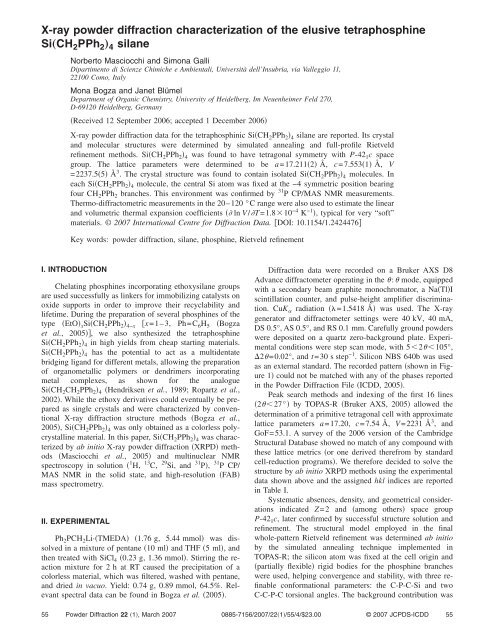
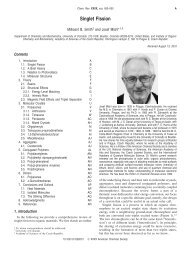
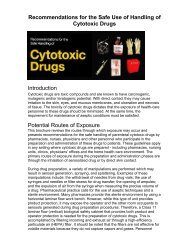
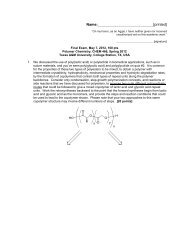

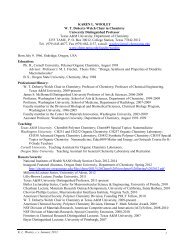
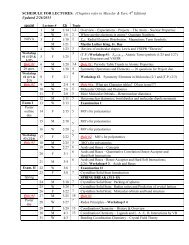
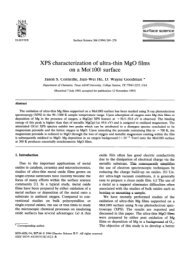
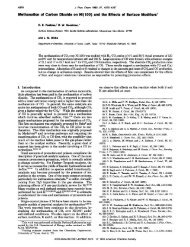
![Radical salts of TTF derivatives with the metal–metal bonded [Re2Cl8]](https://img.yumpu.com/10115211/1/190x253/radical-salts-of-ttf-derivatives-with-the-metal-metal-bonded-re2cl8.jpg?quality=85)



